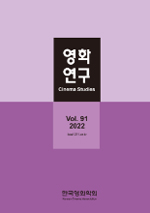- 영문명
- The Posthuman Geun-sae’s Face in Parasite (2019): Body Utopia and Human Machine Dystopia
- 발행기관
- 한국영화학회
- 저자명
- 남승석
- 간행물 정보
- 『영화연구』제91호, 409~459쪽, 전체 51쪽
- 주제분류
- 예술체육 > 예술일반
- 파일형태
- 발행일자
- 2022.03.31

국문 초록
본 연구는 <기생충>(봉준호, 2019)에서의 도시의 지하공간(집)과 거주인(신체) 에 대한 공간재현 방식을 분석하고 그 결과에 대해서 신체의 유토피아와 인간기계의 디스토피아 사이의 신유물론적 접점을 고찰하는 예술철학적 탐색이며 영화 비평이다. 본 연구의 가설은 다음과 같다. “봉준호 영화들의 주요 인물은 신체의유토피아에서 깊이 침잠하는 물질화 과정을 수행하는 존재이다. 그리고 그 과정에서 복잡한 기계의 부분으로 기능하고자 하는 포스트휴먼이다. 그래서 그들은신체의 유토피아와 인간기계의 디스토피아 사이에 존재한다.” 이 가설을 증명하기 위한 연구대상은 <기생충>에서 (신체)물질화의 극단을 형상화하고 있는 근세의 공간(지하 비밀공간)과 신체(얼굴)[과 기택의 공간(반지하)과 신체(얼굴)]이다. 연구방법은 신체의 극단적 물질화 과정의 효과, 곧 신체의 유토피아와 인간기계의 디스토피아의 신유물론적 접점이다. <기생충>에서 박 사장 가족으로 대표되는 부유한 이들의 후각과 가난한 이들을 대표하는 지하공간에 사는 근세(와 기택) 가족의 냄새는 서로의 계급적 차이를 감각적으로 인식하는 인과적 관계로서작동한다. 그리고 다시 냄새에 대한 후각의 인지 과정에서 촉발되는 부정적인 감정(혐오)은 서사의 비극적 사건(살인)의 원인이 된다. 이 영화에서 계급 간의 갈등을 촉발하는 것은 부르주아의 허위의식에 의한 타인의 혐오이다. 이런 혐오의감정이 주요 인물을 신체의 물질화에 침잠하게 하고 결국 인물들의 인간기계화를 강화하며 부품의 단순 교체과정으로서의 개인의 폐기를 초래하는 핵심 추동력으로 작동한다. 그리고 이런 부정적 감정은 극 중에서 개인의 폐기로 형상화되는 근세 얼굴의 해체뿐만 아니라 폐기되는 근세의 대체물로서의 기택으로의 교체로 이끈다. 본 연구는 봉준호 영화들에서 인간기계의 모티브를 설명하기 위해서 인간기계로서의 교체-지속의 메커니즘을 기계인간의 경우와 비교해서 고찰하였다. <기생충>의 근세는 하위계층의 집단의식이 투영된 신체가 극단적으로 물질화된 존재이며 거대기계 속의 단순한 부품, 곧 기계체계 속 인간기계로서 기능하는 포스트휴먼이다.
영문 초록
This study examines the birth of anti-era human machines through the materialization of the body shown in the reproduction method of family and house in Parasite (Bong Joon-ho, 2019). And the core concept is the extreme materialization of the ‘body,’ which is the broad definition of ‘spirit’ and ‘flesh.’ The materialization of the body means the mechanization of the body (mind and body) or the aversive fetishization in Parasite. And it then presupposes a mechanized posthuman in a dystopian world. This study analyzes the transformation through body and space in Parasite and explains the effect of extreme materialization of the body through the dual structure of body utopia and human-machine dystopia. Parasite presents the classic problem concerning class social structure based on negative emotions triggered by smell between the Geun-sae (and Ki-taek) family and the bourgeoisie, centered on the secret underground space (and semi-underground). Geun-sae living the subterranean space becomes a human-machine for working sensor light on the main door of the house. The materialization of the body examines the human mechanization and the dismantlement of the individual as a mechanical replacement through the dismantling of the body and the morphological realization of parasites and hosts. In other words, through the extreme materialization of Geun-sae’s body given to the secret underground space as a human-machine is reconstructed into Ki-taek. Therefore, urban subterranean space shown in Parasite is a result of a representation and in the process of representing the lower orders’ body and space. It simultaneously projects the individual and collective consciousness of the time are considered.
목차
1. 서론
2. 신체의 유토피아, 얼굴의 해체
3. 인간기계의 디스토피아 : 포스트휴먼
4. <기생충>, 포스트휴먼 ‘근세’의 해체된 얼굴
5. 결론
키워드
해당간행물 수록 논문
참고문헌
최근 이용한 논문
교보eBook 첫 방문을 환영 합니다!

신규가입 혜택 지급이 완료 되었습니다.
바로 사용 가능한 교보e캐시 1,000원 (유효기간 7일)
지금 바로 교보eBook의 다양한 콘텐츠를 이용해 보세요!




